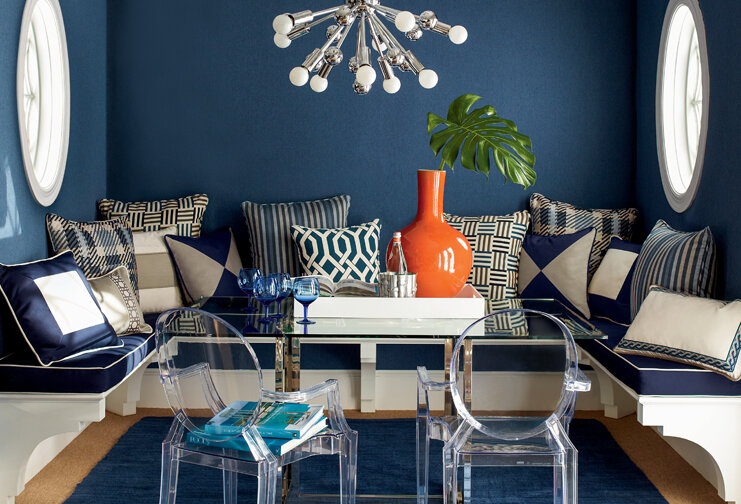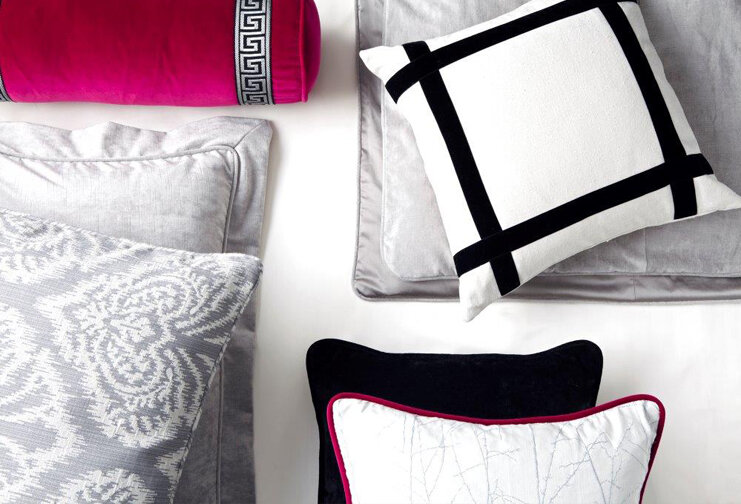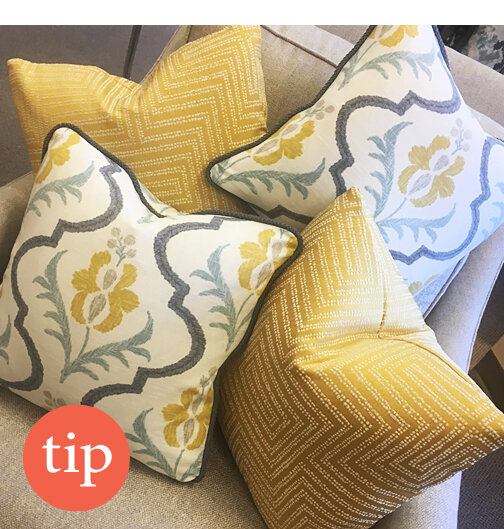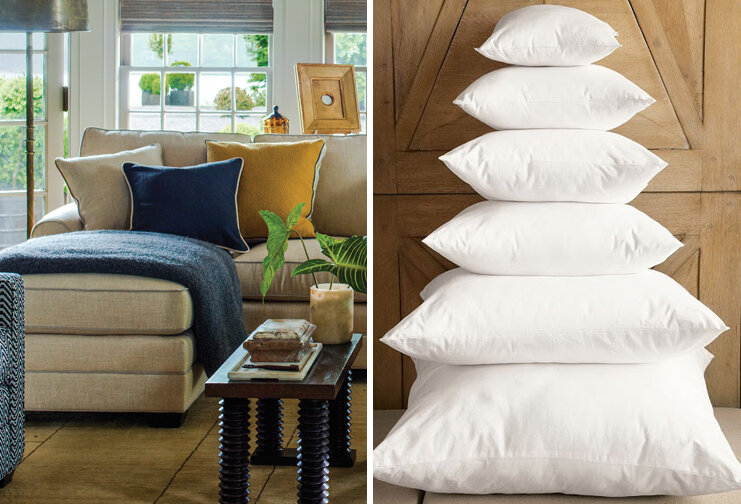Decorative Pillows: Design Experts Share Essential Tips
If you’re looking to update a room in your home, selecting the right decorative pillows can enliven a space and herald to a new season or a fresh style.
“Soft textiles, such as pillows, add so much dimension to a space,” says Lea Johnson of Creekwoodhill. “They’re an easy way to pepper in personality, hints of color, and pattern.”
Destiny Boyd, in-home design consultant with Calico, likens decorative pillows to what she calls the “Little Black Dress Effect.”
“Picture yourself out shopping for that perfect little party number and trying it on in the dressing room. It's just a black dress.” says Boyd. “It is truly the accessories you pair with it that make that little black dress and ensemble! The same effect can be applied to your home in small (often neglected) accessories such as pillows.”
To stay on top of your decorative pillow game, it’s important to understand the basics of selecting and caring for your home’s finishing touches. We asked design experts to share their favorite tips to help you elevate your own pillow decor.
Customizing Decorative Pillows
Homeowners who are looking for an extra-special touch can work with designers and consultants to add details that make pillows one-of-a-kind.
“Fringes, trims, tapes, and contrasting backs—those details are what truly give you that custom look,” says Boyd. “They say to your guests that you thought about every single detail and selection, right down to the very last stitch. Details like that make your house a home.”
How to Mix and Match Throw Pillows
Throw pillows offer homeowners the chance to have fun with their design choices, and mixing and matching pillows is one way to bring different colors and patterns into a space.
“Much like drapery, pillows are the jewelry and finishing touch to every room,” says Kelly Page, lifestyle blogger at BlueGrayGal. “When you have custom pillows, you can bring in gorgeous details to make the space yours.”
Boyd recommends alternating pillows with texture and pattern to keep the look interesting and inviting. “Your spaces crave texture, color, and detail,” she says. “Those are the items that begin to tell your family story throughout your home and are some of the best ways to showcase personality.”
Paul Heintz, interior designer at Local Studio, explains that small patterns can often read like textures, so they can be mixed in with pillows that have larger designs.
Getting the balance right is key to nailing that magazine-worthy look. “If not done correctly, too many large prints can be overwhelming to the eye,” says Heinz. “Conversely, a space devoid of any patterned pillows can feel incomplete.”
How to Mix and Match Pillows on a Sofa
Choosing the right mix of throw pillows for your sofa at home depends on the size and shape of your furniture.
“Typically, for a sofa, I do two 20x20 pillows in each corner and one 16x16 or 18x18 in front on one side,” says Heinz. “Odd numbers of pillows work best. For a sectional, I will do five pillows in two or three fabrics.”
When it comes to high-use areas like the living room, Page takes a less-is-more approach to sofa pillows. “You want your family and guests to sit and relax, not dance around delicate trim,” she says. “I really like to use performance fabrics like Crypton or Sunbrella so they wear well and clean easily.”
Johnson adds that it’s better to choose a few larger pillows than a lot of small ones when decorating a sofa. “Larger pillows (22-inch to 26-inch squares) look better than a bunch of small 18-inch or smaller pillows,” she says. “I even love a large, oversized lumbar pillow on a sofa without any other pillows for a clean, modern aesthetic.”
How to Decorate a Bed with Pillows
In bedrooms, don’t assume that you need lots of pillows to achieve a luxurious look.
“Sometimes less is more. I like to keep beds simple when it comes to pillows,” says Heinz, who recommends finishing the bed with two sleeping pillows, two Euro shams that are 26x26 inches, and a decorative pillow in front.
Page also prefers to keep her bed pillows minimal in the master bedroom. “I have two beautiful silk pillows with gold and gray that pull out the rich tones of the bedroom, but are still easy to remove for sleeping so my husband doesn't go crazy!” she says. “Having a custom lumbar pillow made to fit your bed is another beautiful way to create a finished look.”
The same rules apply to decorative pillows on guest beds—the fewer the better. “I prefer there be just enough to make the room feel special, but not so much that you make your guests wake up with a mountain of pillows on the floor,” says Page.
To make guest bedrooms feel special, create one or two custom pillows, sized to fit the bed, using beautiful fabric and eye-catching trim.
Decorative Pillow Sizes
Choosing the perfect decorative pillow for your space starts by identifying the right pillow sizes. Designs can fall flat if the sizing is too small or too large for a piece of furniture or a particular room.
“Scale is especially important when it comes to sizing pillows,” says Heintz.
According to Heintz, the following decorative pillow sizes are most common:
16x16 inches
18x18 inches
12x24 inches
20x20 inches
Custom-made pillows offer a wide range of options, so you don’t need to compromise. Heinz often uses a mix of multiple sizes to get the look he wants.
If you’re unsure about which size to choose for your decorative pillows, Johnson says to opt for a few larger pillows instead of lots of small ones.
“I love oversized pillows—especially an oversized lumbar pillow,” she says. “If I have a client on the fence over pillows, I try to steer them towards larger 22-inch or 26-inch pillows versus an 18-inch pillow.”
Tips for Decorative Pillow Inserts
Although choosing a decorative pillow insert may seem as easy as sizing the insert to match the cover, designers suggest a different approach.
In addition to selecting the right size insert, you need to consider the type of fill available for the insert. The fill will ultimately determine how firm your pillows look on a sofa or bed.
“There is a polyfill that gives it a very plumped look if it's a room that needs structure,” says Page. “Or you could do a soft insert for a relaxed, cozy feel.”
Softer inserts are generally made from a feather/down blend. Using a blended pillow insert is something that Heinz prefers for his design projects.
“This allows for soft pillows that have a great shape and can easily be fluffed up.”
How to Clean Decorative Pillows
To keep your pillows looking great, cleaning is essential. But throwing decorative pillows into the washing machine is not recommended.
“Think of them like your fanciest dress,” says Page. “You wouldn't throw it in the laundry with towels, would you?”
Dry cleaning is often recommended for decorative pillows, especially if they have embellishments like beading or trim.
“A good cleaner will be able to bring your pillows back to life,” says Heinz. “The best way to make sure it is done right is keep a fabric sample with the material content on the back and show this to the cleaner.”
Between dry cleaning appointments, Page recommends taking the pillows outside to dust them off or lightly run a vacuum brush over them to remove dirt and debris like pet hair.
Calico can help you create the custom decorative pillows to complement your room. Choose from a variety of shapes and sizes, and select from more than 5,000 fabric options, including stain-resistant performance fabrics.










